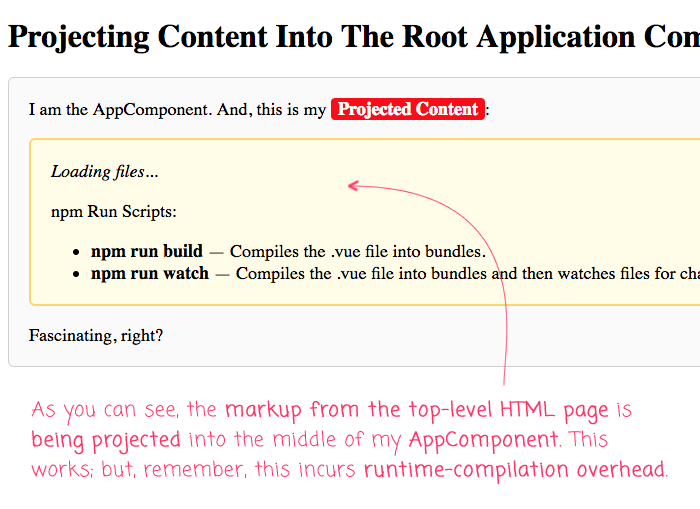Slot Example Vue
- Slot Example Vue Online
- Slot Example Vue Test
- Slot Example Vue Bar
- V-slot Example Vuejs
- Vue Slot Example
- For real-life, powerful examples of scoped slot usage, we recommend browsing libraries such as Vue Virtual Scroller, Vue Promised, and Portal Vue.
- Slots are a mechanism for Vue components that allows you to compose your components in a way other than the strict parent-child relationship. Slots give you an outlet to place content in new places or make components more generic. The best way to understand them is to see them in action. Let’s start with a simple example.
- Nov 06, 2019 In the next parts, we show you some examples that apply new Vue v-slot directive in practice. Vue v-slot examples with Named Slots. If we want to use multiple slots in one component, Named Slots are useful. The code below shows BkrCard component template with 3 slots: header; title; default.
- May 07, 2020 Next Up, Let’s review Named Slots in VueJS with the help of an example. We covered a lesson on slots in VueJS in the last section. Slots help us to take the defined content inside the HTML markup of the component and put them in wherever specified in the template. The problem is it only works for a single default slot. But what if we want to create more complex markup, where we are looking.
For real-life, powerful examples of scoped slot usage, we recommend browsing libraries such as Vue Virtual Scroller, Vue Promised, and Portal Vue. Deprecated Syntax. The v-slot directive was introduced in Vue 2.6.0, offering an improved, alternative API to the still-supported slot and slot-scope attributes.
This page assumes you’ve already read the Components Basics. Read that first if you are new to components.
Slot Content
Vue implements a content distribution API that’s modeled after the current Web Components spec draft, using the <slot> element to serve as distribution outlets for content.

This allows you to compose components like this:
Then in the template for <navigation-link>, you might have:
When the component renders, the <slot> element will be replaced by “Your Profile”. Slots can contain any template code, including HTML:
Slot Example Vue Online
Or even other components:
If <navigation-link> did not contain a <slot> element, any content passed to it would simply be discarded.
Named Slots
There are times when it’s useful to have multiple slots. For example, in a hypothetical base-layout component with the following template:

For these cases, the <slot> element has a special attribute, name, which can be used to define additional slots:
To provide content to named slots, we can use the slot attribute on a <template> element in the parent:
Or, the slot attribute can also be used directly on a normal element:

There can still be one unnamed slot, which is the default slot that serves as a catch-all outlet for any unmatched content. In both examples above, the rendered HTML would be:
Default Slot Content
There are cases when it’s useful to provide a slot with default content. For example, a <submit-button> component might want the content of the button to be “Submit” by default, but also allow users to override with “Save”, “Upload”, or anything else.
To achieve this, specify the default content in between the <slot> tags.
If the slot is provided content by the parent, it will replace the default content.
Compilation Scope
When you want to use data inside a slot, such as in:
That slot has access to the same instance properties (i.e. the same “scope”) as the rest of the template. The slot does not have access to <navigation-link>‘s scope. For example, trying to access url would not work. As a rule, remember that:
Everything in the parent template is compiled in parent scope; everything in the child template is compiled in the child scope.
Scoped Slots
New in 2.1.0+
Sometimes you’ll want to provide a component with a reusable slot that can access data from the child component. For example, a simple <todo-list> component may contain the following in its template:
But in some parts of our app, we want the individual todo items to render something different than just the todo.text. This is where scoped slots come in.
Slot Example Vue Test
To make the feature possible, all we have to do is wrap the todo item content in a <slot> element, then pass the slot any data relevant to its context: in this case, the todo object:
Now when we use the <todo-list> component, we can optionally define an alternative <template> for todo items, but with access to data from the child via the slot-scope attribute:
In 2.5.0+, slot-scope is no longer limited to the <template> element, but can instead be used on any element or component in the slot.
Destructuring slot-scope
The value of slot-scope can actually accept any valid JavaScript expression that can appear in the argument position of a function definition. This means in supported environments (single-file components or modern browsers) you can also use ES2015 destructuring in the expression, like so:
Slot Example Vue Bar
This is a great way to make scoped slots a little cleaner.